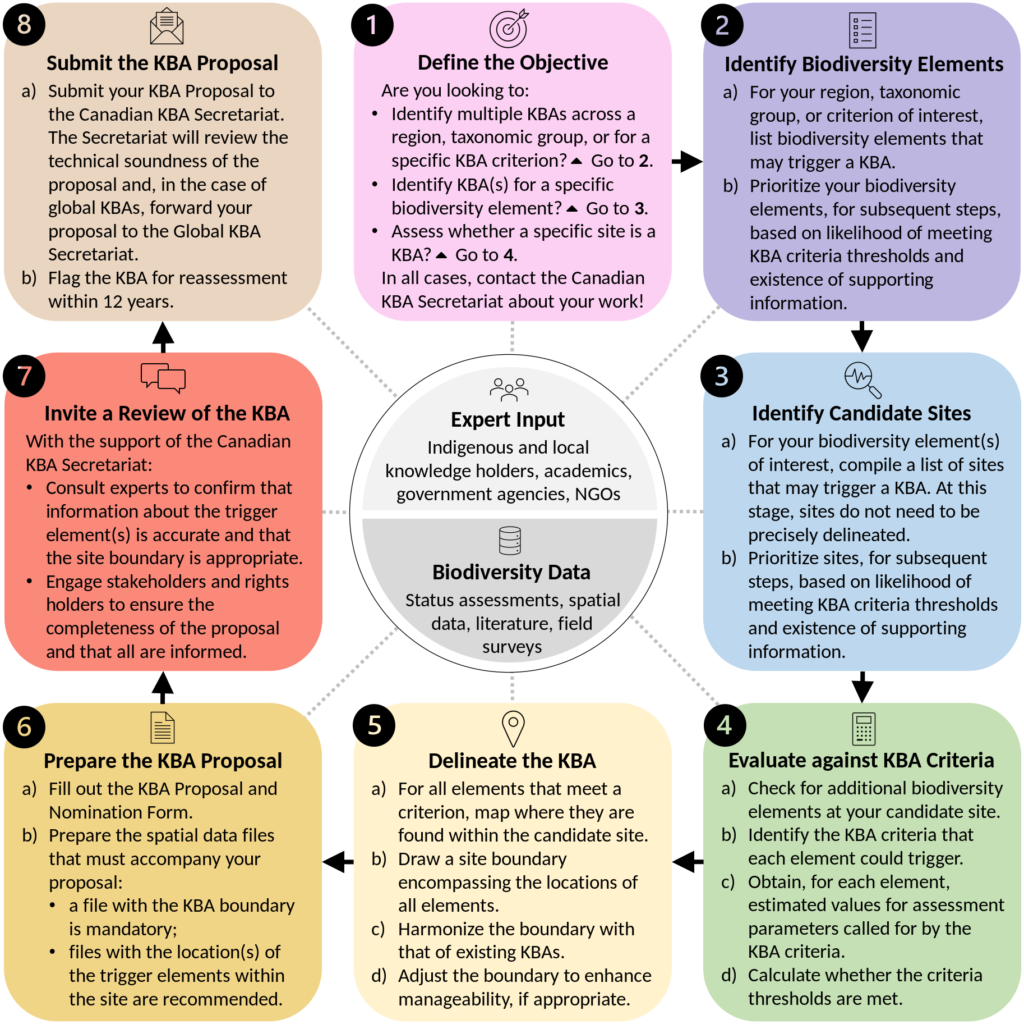Our planet is facing an increasingly uncertain future. The growing extinction crisis, accelerating impacts of climate change and an ever-growing human footprint are significantly reducing biological diversity and the integrity of ecosystems. Countries around the world have recognized that more must be done to slow the rapid decline of biodiversity.
KBAs are sites that contribute to the persistence of biodiversity nationally and globally. Found across land, freshwater, and marine environments, KBAs support rare and threatened species and ecosystems, as well as key natural processes. They range in size from small patches of habitat to large tracts of land or water. KBAs are designated based on specific, measurable criteria. The designation does not give the site a particular management prescription or legal status. KBAs may encompass private or public land, sometimes overlapping, partially or entirely, with legally protected sites.
The KBA Program strives to ensure that sites are properly identified, their values are well documented and effectively managed, and that these places are adequately safeguarded and receive appropriate resources.

Through the International Union for the Conservation of Nature (IUCN) Taskforce on Biodiversity and Protected Areas, countries and conservation organizations have come together to create a new system for identifying such areas. This system was outlined in IUCN’s global standard for the identification of Key Biodiversity Areas (KBAs), and adopted in 2016. It is a system based on strong scientific criteria and can be applied to all species and ecosystems, combining and streamlining the many tools and approaches that have been used to prioritize different biodiversity elements in the past (e.g., Important Bird and Biodiversity Areas).
A National Standard for KBAs in Canada was published in 2021 to allow for the identification of sites critical to the conservation of biodiversity at the national scale. In Canada, both globally and nationally significant sites are now being identified across the country. The numerous areas being identified as KBAs across Canada demonstrate the often underappreciated richness, diversity and intactness of Canadian biodiversity and landscapes.
KBAs have characteristics that make them important for sustaining species and ecosystems. They are identified using five criteria that pertain to:
The science-based and measurable KBA criteria make them a trusted tool for conservation, but KBAs don’t capture all values important for conservation. KBAs complement information about biocultural values, climatic refugia, ecosystem services, and landscape connectivity at sites, and can support other species-specific and landscape-scale approaches to conservation. For an in-depth, technical summary of the KBA criteria, visit here.
Canada has one of the world’s first comprehensive national programs to identify KBAs and was the first country to adapt the Global KBA Standard to a national context. In 2019, the KBA Canada initiative was launched as part of the Pathway to Canada Target 1 process designed to help Canada meet protected area targets and other targets agreed to in the Convention on Biological Diversity. This was the starting point for work to identify, delineate, and review KBAs across the country. This work is led by the KBA Canada Coalition, a collaborative initiative involving non-governmental organizations, governments, Indigenous partners, academic institutions, experts and knowledge-holders that are engaged in the work of identifying, delineating and reviewing KBAs. The KBA Canada Secretariat is responsible for coordinating KBA proposal development and a Steering Committee is responsible for accepting these proposals at the national level.
KBAs can be used to advance or support diverse conservation goals. Identification of KBAs does not automatically lead to formal protection or management requirements and has no impact on access to land. But knowing where these critical sites are is important and can feed into many processes. For example, KBA information is being used to inform protected-areas planning in the context of achieving Canada’s goal of 30% of land and oceans protected by 2030 by ensuring that areas that are important for biodiversity are considered for protection or other forms of stewardship. KBAs can be used in other conservation planning to ensure that conservation efforts and land acquisitions are focused on the places that matter most. Other potential uses could include recognizing and celebrating existing or ongoing stewardship efforts, accessing funding for stewardship, using information to ensure any threats to the site are managed, and highlighting opportunities for monitoring and communication about species and ecosystems.
Important Bird and Biodiversity Areas (IBAs) are sites that are designated for large groups of birds or for species at risk. The IBA program is a global conservation initiative of BirdLife International, which has IBA partners in almost all countries. IBAs have been important for engaging stewards through the Caretaker Network, establishing conservation reserves, and guiding land-use decisions. The considerable investment already made in IBAs, and the similarity in criteria, make IBAs an obvious foundation for identifying KBAs in Canada and worldwide.
In the late 1990s, Birds Canada led a comprehensive process to identify IBAs, resulting in nearly 600 sites being designated across every province and territory. These sites support important populations of birds in coastal areas, wetlands, grasslands, forests, and upland habitat. Similar to KBAs, designation of IBAs is based on criteria that are internationally agreed upon, standardized, quantitative, and scientifically defensible.
Birds Canada has undertaken an analysis to assess existing IBAs against the KBA standard. Within the KBA context, these sites will continue to be recognized for their importance to birds, as well as for a broader range of exceptional biodiversity and ecosystem values. Identifying additional species and ecosystems will deepen our understanding of the ecological value of each site, and confirm what we already know: IBAs are good not only for birds, but for all biodiversity.
In addition to IBAs, KBAs build off the experience of other efforts to identify important sites for biodiversity, such as Alliance for Zero Extinction (AZE) sites, Important Plant Areas (IPAs), and Important Amphibian and Reptile Areas (IMPARA), all of which already exist in Canada. Any of these sites that meet KBA criteria will be added to the network of KBA sites.